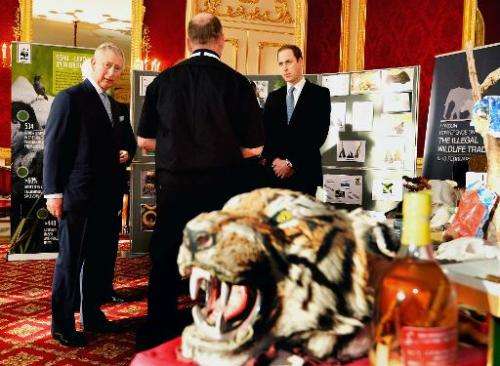Threatened A-listers of the animal world

The 40 countries meeting here Thursday to seek a landmark declaration on the illegal trade of wildlife have said they are particularly concerned about the plight of elephants, rhinos and tigers, prized for their tusks, horns and skins.
Illegal trafficking is a particular threat to big game in Asia and Africa, as well as to sharks and Chinese Pangolins, the source of some traditional medicines.
The Convention on International Trade in Endangered Species of Wild Fauna and Flora (CITES) forbids the sale of more than 600 animal species, including great apes, sea turtles, crocodiles and snakes.
It was first adopted in 1973, has been signed by 178 countries and sets strict limits on the sale of around 4,500 animal species.
But poachers thrive nonetheless. In Africa, the number of rhinoceroses killed shot up by 43 percent from 2011 to 2012, according to the International Union for Conservation of Nature, despite a ban in effect since 1977.
South Africa, home to about 80 percent of all the world's rhinos, reported that more than 1,000 were killed last year.
Meanwhile, the World Wildlife Fund (WWF) has estimated that the number of wild tigers has plunged from 100,000 in 1900 to around 3,200 at present.
And across Africa, the elephant population is now estimated at less than 500,000 whereas several million lived there in the mid-1900s.
Poaching accounts for much of that loss.
Despite a 1989 ban on ivory sales, trafficking has doubled since 2007 and more than tripled since 1998 according to a report released last March on the sidelines of a CITES conference.
The spread of cities to the detriment of natural habitat has also hammered jungle heavyweights.
The Swiss-based IUCN's latest Red List of Threatened Species included 11,212 animal species from a total of 53,267 kinds of vertebrates and invertebrates.
A breakdown of the IUCN data showed that one in four mammal species, one of every eight birds and more than one in three amphibians are threatened with extinction.
The CITES decided last year to tighten regulations on trade in five kinds of sharks, while the non-governmental organisation Traffic estimates the total value of trade in shark fins at more than $480 million per year.
According to the UN Food and Agricultural Organisation (FAO), 100 million sharks are killed annually, and 90 percent have disappeared within the past 100 years.
© 2014 AFP



















